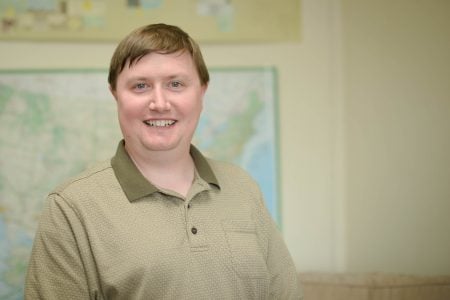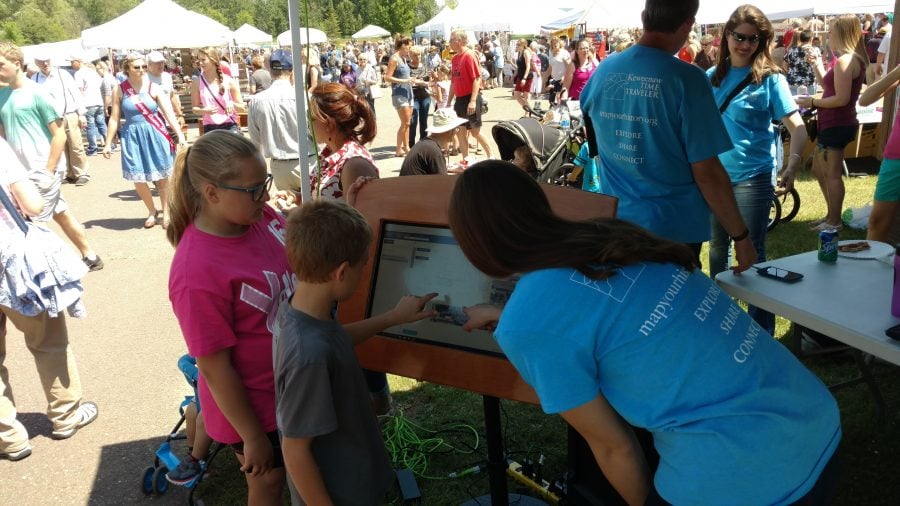An advanced institute in the spatial and digital humanities is coming to Michigan Tech.
Don Lafreniere, a professor of geography and geographic information science (GIS) in Tech’s Department of Social Sciences is leading a team of researchers, staff, and students from Michigan Tech and Wayne State University on project that will develop the National Endowment for the Humanities (NEH) Community Deep Mapping Institute. The project is supported by a $250,000 NEH grant.

The Institute will run for one year, beginning in January 2025. It will operate virtually throughout the year and also includes an immersive, two-week on-site component that will take place at Michigan Tech in July 2025.
Co-hosted by Tech and Wayne State University, the Institute will bring 40 people from around the world to Houghton and the surrounding region to learn about deep mapping and the other technologies used in the award-winning Keweenaw Time Traveler and the subsequently developed Hamtramck Explorer.
The grant is further evidence of the power and potential of deep maps like the Keweenaw Time Traveler, which enables citizen researchers to both explore history and add the layers of their own historical community knowledge to the interactive platform, providing a model that can be adapted anywhere where people are interested in how their communities developed.
“This institute will teach people around the world how to integrate spatial technologies together with historical information about their local places to help communities learn more about their geography, history, and cultural heritage,” said Lafreniere.
The Deep Mapping Institute was one of four projects in the nation awarded funds totaling $963,499 as part of the NEH’s Institutes for Advanced Topics in the Digital Humanities. The intent of the four projects in this category center on providing scholars, advanced graduate students, and practicing professionals with the opportunity to deepen their knowledge of advanced technology tools and methodologies relevant to the humanities and social sciences and to increase the number of scholars using digital technology in their research. The institutes are part of the recent NEH funding cycle that included $37.5 million in grants overall for 240 humanities projects.
A Collaboration Between Two State Universities
The project springs from a collaboration between MTU and Wayne State University that began in 2020 during the COVID-19 pandemic. During this time, MTU and WSU faculty and students started working together on the Hamtramck Spatial Archaeology Project, another NEH-funded initiative focused on the small industrial city within the boundaries of Detroit.
Project co-directors include Sarah Scarlett, associate professor of history, Mark Rhodes, assistant professor of geography, and Dan Trepal, senior geospatial research scientist, all from Michigan Tech, and Krysta Ryzewski, professor of anthropology at Wayne State University.
Confronted by the challenge of restricted access to archival, museum, and archaeological resources, Ryzewski, Trepal, and Lafreniere were inspired to partner with Hamtramck Historical Museum to construct the explorer prototype. The Hamtramck Explorer includes more than 130 digitized historic maps cross-linked to historical museum collections, along with related archaeological data.
“This deep map has since grown into an invaluable research, preservation, and storytelling resource that makes historical information accessible to the public and encourages community dialogues around the themes of preservation, immigration, and local history,” said Ryzewski. “Today, the team continues to work on expanding the Hamtramck Explorer to cover the entire area of the two-square-mile city, and to equip it with capabilities that allow the public to contribute content.”
The newly funded NEH Community Deep Mapping Institute takes the dual-university collaboration to an expanded level. Starting in January 2025, dozens of Michigan Tech and Wayne State students, faculty, and staff will participate, alongside 40 social science, humanities, and heritage-focused professionals from around the world.
“We’re excited about the opportunity to share the benefits of our state-level collaboration with more colleagues as we create new digital resources and amplify the impacts of deep mapping internationally,” said Ryzewski. “Institute fellows from across the US and around the world will develop projects that increase public access to historical data, advance community engagement, and foster innovation in the digital and spatial humanities.”.
The NEH Community Deep Mapping Institute in-person component will take place July 7-18, 2025 at Michigan Tech, located in Michigan’s Upper Peninsula on the shores of Lake Superior’s Keweenaw Peninsula.
Fellowship Application Deadline is November 22
The Institute seeks to fund fellows or teams of fellows who wish to learn the range of skills necessary to create their own public-facing deep map. “The intent is to create a diverse group of fellows including students, early career to senior scholars, and professionals in history and heritage who work with public audiences including public historians, interpreters, and those who work in museums, parks, and historic sites and houses.
Lafreniere said fellows will “learn a wide range of technical and professional skills that are needed to successfully develop their own deep mapping projects including basic GIS skills, digital spatial storytelling, public engagement strategies, and how to integrate deep maps with augmented and mobile technologies.”
Fellows will also benefit from developing new partnerships with other deep- mapping scholars and public-facing professionals. “They will have access to a team of experts in a wide variety of fields, including the digital and spatial humanities, archaeology, geography, GIS, history, heritage interpretation, library and archives, public history, and experts in community-based researchers,” Lafrieniere said
Applicants selected to be fellows will receive a stipend to support travel to and from the Keweenaw and meals Fellows will be in residence at the Laurium Manor Inn during their time in the region.
You can learn more about the criteria and apply for a fellowship on the Deep Mapping Institute website.
About the College of Sciences and Arts
The College of Sciences and Arts strives to be a global center of academic excellence in the sciences, humanities, and arts for an increasingly technological world. Our teacher-scholar model provides the foundation for experiential learning, innovative research and scholarship, and civic leadership. The College offers 33 bachelor’s degrees and 25 graduate degrees and certificates. The College conducts approximately $12,000,000 in externally funded research in health and wellness, sustainability and resiliency, and the human-technology frontier.
Follow the College on Facebook, Instagram, LinkedIn, X and the CSA blog. Questions? Contact us at csa@mtu.edu.
